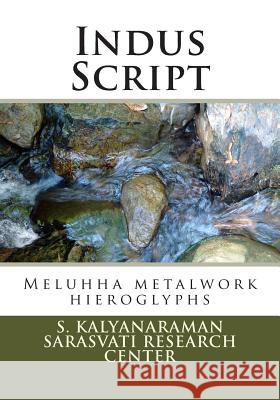Indus Script: Meluhha Metalwork Hieroglyphs » książka
Indus Script: Meluhha Metalwork Hieroglyphs
ISBN-13: 9780991104833 / Angielski / Miękka / 2014 / 804 str.
Who were the ancient people who created the script and what purpose did it serve? 1. The creators of the script are Meluhhans, ancestors of present-day people of India. 2. The script catalogs Bronze Age metalwork and trade. 3. Indus Script inscriptions are the earliest examples of use of catalogs in civilizational history in Eurasia necessitated by metalwork in great demand during those times, about 5,600 years before present (BP). The book announces a decipherment of Indus Script based on detailed transcription, reading and translation of about 2000 inscriptions. It reports a discovery that the writing system relates to metalwork and trade by Sarasvati Sindhu (Hindu) civilization artisans of Ancient India. The work is a tribute to the ancient metalworking artisans of India of 4th millennium BCE, who invented an early writing system of mlecchita vikalpa, now called Indus Script. Mlecchita vikalpa was listed as one of 64 arts and a part of the educational curriculum of Ancient India. The book is a narrative of metallurgical technologies in Ancient India during the Bronze Age, an evolution of 'coppersmiths' (cimara) into 'lost wax casting' smiths (dhokra) working with a variety of alloys. Meluhha hieroglyphs document Bronze Age trade on Tin Road from Malhar, Uttar Pradesh, India to Haifa, an ancient port of Israel. The script transcribes Proto-Indian speech of Meluhha (mleccha) language glosses. Rebus cipher -- homonymous glosses of Meluhha -- provide plaintext readings of hieroglyphs and prove that ciphertext rebus renderings detail traded resources and processes of Bronze Age, mostly stone, mineral, metal and alloyed artifacts as catalogs in Meluhha language. Meluhha lapidaries who worked with shells, carnelian or agate or lapis lazuli to create drilled beads could do metalwok smelting other metallic stones which were mineral ores and metallic compounds. Bronze Age necessitated a writing system to document the quantum leap in technological complexity of casting techniques using metallic stones, in smelters, to produce new resources of metalware, ingots, and hard alloys of copper, tin, zinc, arsenical bronze, tin bronze, brass, pewter, iron, lead, gold or silver. One such alloy was documented in a hieroglyph composition and Meluhha cipher using a backbone-spine metaphor. A remarkable semantic unity among present-day Indian languages is established traceable to the days of Sarasvati Sindhu (Hindu) civilization ca 4th millennium BCE. Many glosses identified by the deciphered Meluhha Indus Script hieroglyphs are demonstrated in the lexical repertoire of all Indian languages validating a hypothesis that Meluhha-Mleccha was the fountain-spring of Indian sprachbund and a veritable parole, lingua franca of the nation founded by the organized brilliance of the Bronze Age experts like smelters, artisans - metal- and stone-workers, stone-cutters, inventors of new metal alloys, cire perdue casting experts, and traders. This semantic unity of Indian sprachbund from Bronze Age days, explains why anyone of the present-day glosses from any one of the Indian languages adequately explains and validates Meluhha rebus cipher. Two contentious academic debates on identities of Meluhha speakers and details of language spoken by ancient artisans and traders providing the foundation of Indian sprachbund are resolved: 1.Meluhha speakers were Bronze Age artisans whose products were traded in Ancient Near East and Fertile crescent. They are exemplified by later-day legatees called Asur of Chattisgarh and Assur of Ancient Near East. 2. Meluhha language was the lingua franca of ancient India. Vedic was a version of this language in poetic diction called chandas of Indian sprachbund. Thus, the roots for hundreds of glosses of present-day languages of India of over one billion people are traced back in millennia to rebus ciphertexts of Meluhha hieroglyphs as trade documents of Bronze Age-calling cards of seafaring artisans (on sangada).











